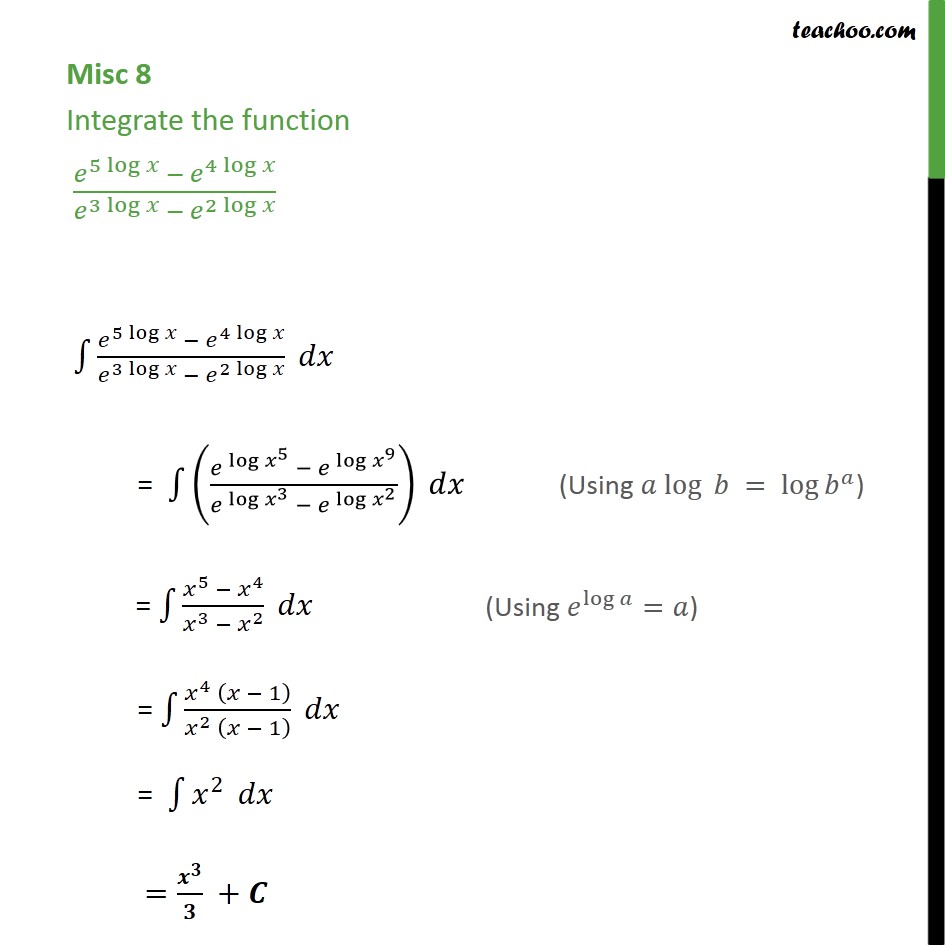
The formula of integral of log x with base a is given by ∫log ax dx = x(log ax - log ae) + C, where C is the integration constant. What is the Formula of Integral of Log x with Base a? The inverse logarithm (or anti logarithm) is calculated by raising the base b to the logarithm y: x log-1 (y) b y. The integral of log x whole square is equal to ∫(log x) 2 dx = x + K. Natural logarithm (ln) Natural logarithm is a logarithm to the base e: ln(x) log e (x) When e constant is the number: or. What is the Integration of Log x Whole Square?

This can be determined using the formula ∫log ax dx = x(log ax - log ae) + C, where we substitute a = 10. The integration of log x with base 10 is equal to x(log 10x - log 10e) + C. What is the Integration of Log x With Base 10? In this formula, we assume u = ln x and dv = dx and solve the integral using the formula. The integral of ln x can be calculated using the integration by parts formula given by ∫udv = uv - ∫vdu.
.png)
In calculus, integration by parts or partial integration is the method which is mostly used to find integration of the product of the two functions. For integrating this function the best method to be used is integration by parts.

#Integration of xlog x how to
We can evaluate the integral of ln x (integration of log x with base e) using the integration by parts formula How to Find the Integration of Ln x dx? Complete step-by-step answer: Let us represent the given function by f (x). The formula for the integration of ln x dx is given by, ∫ln x dx = xlnx - x + C. Lets say you had the basic function y ln(x). Note: This is a different rule from the log rule for integration, which allows you to find integrals for functions like 1/x. What is the Integration of Log x Formula? Integral of Natural Log ln(x) The general rule for the integral of natural log is: ln(x)dx x Here, the function log x is considered with base e which is an exponential number. Corp A McKinsey survey of more than 1,400 integration executives, for example. The integration of log x is equal to xlogx - x + C, where C is the integration constant. air conditioner leaking white foam x particles cloth self collision. 1.įAQs on Integration of Log x What is Integration of Log x in Calculus? Using (1d) from this answer log(sin(x)) log(2) k 1cos(2kx) k we get / 2 0 xlog(sin(x))dx / 2. We will also calculate the definite integration of log x with different limits and solve examples using the integral of ln x for a better understanding of the concept. One may tackle the equivalent integral / 20 x2cot(x)dx also by recalling that cot(x) 1 x + n 1( 1 x n + 1 x + n), but symmetry is definitely not enough to carve the (3) term out of thin air. After using the formula of integration by parts, you need to simplify the equation, and hence, you will. In this article, we are considering log x with base e by default. You need to use the technique of integration by parts. Mathematically, we can write the formula for the integration of log x, ∫log x dx = xlogx - x + C (OR) ∫ln x dx = xlnx - x + C, where log x or ln x are the natural logarithmic function.įurther in this article, we will evaluate the integral of ln x or log x with base e using the integration by parts formula. Therefore, the integral of ln x gives the area under the curve of the function f(x) = ln x. What is the Integration of Log x Whole Square The integral of log x whole square is equal to (log x) 2 dx x (log x) 2 - 2log x + 2 + K. Apply integration by parts ( 47 ) take log x as the product of 1 and log x, and begin by integrating the factor 1. Click hereto get an answer to your question Evaluate: int xlog(1 + x) dx. This can be determined using the formula log a x dx x (log a x - log a e) + C, where we substitute a 10. The integral of a function gives the area under the curve of the function. The integration of log x with base 10 is equal to x (log 10 x - log 10 e) + C. We can evaluate the integral of ln x (integration of log x with base e) using the integration by parts formula (also known as the UV formula of integration). It's derivative is 1/x everywhere on its domain.īUT, this answer is actually not totally correct.The integration of log x is equal to xlogx - x + C, where C is the integration constant. Most textbooks say that the integral of 1/x over its entire domain is ln(|x|) + c, and this is probably what your teacher is looking for.

If you were just integrating over the positive reals, then ln(x) + c or log(x) + c would be correct. This is a disconnected domain, unlike the domain of most functions you're integrating. My best guess is that he wants the integral of 1/x over its entire domain, namely x =/= 0.


 0 kommentar(er)
0 kommentar(er)
